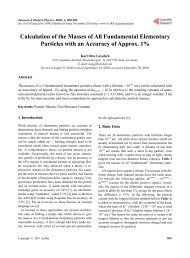In-gel digest (Coomassie stained) with trypsin - Proteomics
In-gel digest (Coomassie stained) with trypsin - Proteomics
In-gel digest (Coomassie stained) with trypsin - Proteomics
Create successful ePaper yourself
Turn your PDF publications into a flip-book with our unique Google optimized e-Paper software.
Proteomic protocols for mass spectrometry<br />
<strong>In</strong>-<strong>gel</strong> <strong>digest</strong>ion<br />
• Add just enough freshly prepared enzyme solution (in 25 mM NH4HCO3 ) to cover the<br />
<strong>gel</strong>.<br />
• <strong>In</strong>cubate at 37°C for 30 minutes.<br />
• Remove excess enzyme solution.<br />
• Add enough 25 mM NH4HCO3 (approx. 2-3µl) to keep the <strong>gel</strong> wet overnight, but avoid<br />
excess liquid.<br />
• <strong>In</strong>cubate at 37°C overnight.<br />
Extraction of peptides<br />
• Apply extraction buffer enough to cover the <strong>gel</strong> plugs completely, but avoid too much of<br />
excess volume (dilution of sample!). Support of the extraction by ultrasonication for a few<br />
minutes may improve the extraction yields. Recommended time frame for extraction:<br />
30min at room temperature.<br />
• The optimum composition of the extraction buffer will depend on the nature of the protein<br />
<strong>digest</strong>ed and on the aim of analysis respectively, and, to certain extent, on the MALDI<br />
preparation protocol you are going to use. For a number of applications, application of<br />
only one extraction buffer of a certain composition (ranging from 100/0 to 50/50 TF<br />
enough A 0.1% / ACN) may be sufficient, f.i. for many routine protein identification<br />
tasks. However, stepwise extraction using buffers of increasing ACN content may<br />
improve the overall sequence coverage achieved in the following MALDI-TOF analysis.<br />
Keep in mind also, that some prep protocols, f.i. Anchorchip Thin Layer (ACTL), require<br />
the absence of any organic solvent in the peptide solution. Applying this preparation<br />
protocol, you have the choice: either you extract using a buffer containing ACN, which<br />
forces you to remove it from the extract prior to MALDI preparation, or you avoid any<br />
ACN in the extraction buffer, which allows you to save the subsequent evaporation step,<br />
but may lead to a certain under-representation of those peptides which are less soluble in<br />
pure aqueous solvent.<br />
Mass spectrometric peptide analysis<br />
• If purification is necessary, perform ziptip or microcolumn purification. Alternatively,<br />
Anchorchip Thin Layer (ACTL) is a MALDI prep protocol, which is able to treat<br />
contaminated samples in a very efficient manner. Please refer to the Anchorchip manual<br />
in this matter.<br />
General remarks<br />
Size of <strong>gel</strong> pieces: Cut as close to the protein band as possible to reduce the amount of<br />
"background" <strong>gel</strong>. Avoid to use <strong>gel</strong> pieces much bigger than 1 mm x 1 mm.<br />
2<br />
Version 1.0, 6.12.2000




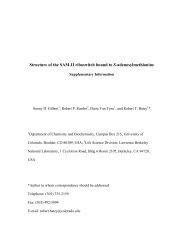
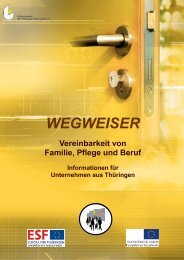
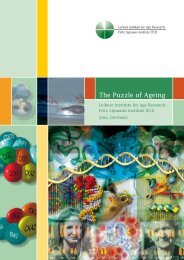

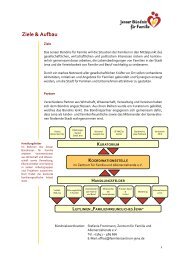



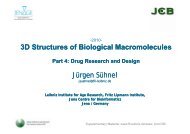
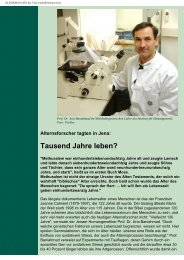

![Programm [pdf]](https://img.yumpu.com/20944039/1/184x260/programm-pdf.jpg?quality=85)
